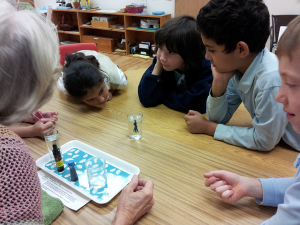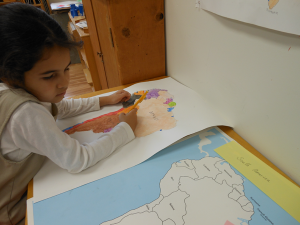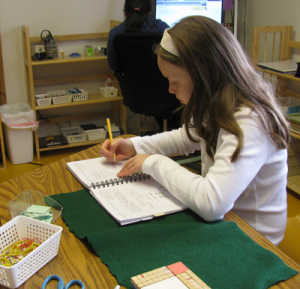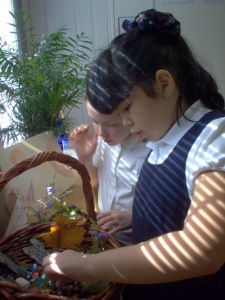“Knowledge can be best given where there is eagerness to learn, so this is the period when the seed of everything can be sown, the child’s mind being like a fertile field, ready to receive what will germinate into culture.” -Maria Montessori
Lower Elementary
Lower Elementary (ages 6 to 9 years)
Grades 1 – 3

Now the child is reaching out beyond his immediate world to the farthest reaches of the universe. His imagination and drive for discovery can take him anywhere, and the lower elementary classroom is designed to assist the child in this journey. The story of the birth of the universe and our planet is enriched by experiments explaining difficult concepts. The history of the earth and the development of plants and animals come alive through the Timeline of Life.
The beautiful natural environment surrounding the school provides opportunities to explore and appreciate the world outside the classroom walls. Activities and lessons within the classroom enhance and explain the world of nature.
The work done in the Montessori preschool is the foundation for the elementary years. Learning through manipulative materials is still vital to the elementary-age child and the beautiful hands-on Montessori materials continue to be used in every area of the curriculum. Now the child uses the materials to help him come independently to abstract understandings of language and mathematical concepts. He continues to choose and explore his own individual interests, but in the lower elementary classroom he may do so with the companionship of other children in group projects and shared activities.

Learning to make sense of the world includes responding to each individual’s responsibility for the planet, including our immediate environment and the global community. Peace education, community service projects, international guest speakers, and field trips designed to enhance awareness are all part of the curriculum.
Physical education builds self-confidence and strong bodies. The academic curriculum is integrated with art and music projects, as well as lessons to learn specific skills, all of which help the child learn to appreciate the beauty and creativity of the world outside and within ourselves.
For information about Upper Elementary (ages 9 – 12)
Upper Elementary
Upper Elementary (ages 9 – 12)
Grades 4 – 6

The work of the lower elementary continues into the upper elementary classroom. The child continues to follow his interests in the cultural subjects of geography, history, and science, but now he is capable of using the skills attained in the lower elementary classroom and his ability to work on a more abstract level to pursue these interests in more depth.
Continuing throughout the upper elementary years with the same teachers helps the child identify and enhance academic strengths and meet challenges with confidence.
- The core subject of mathematics is extended into pre-algebra and geometry.
- Language flows into literature, research writing and grammar and poetry.
- Science expands into chemistry, biology, and cultural studies.
- The curriculum is enriched with foreign languages (French, Arabic, Japanese), technology, art, music, and physical education.
- Computer technology includes keyboarding and projects involving PowerPoint presentations, guided research, word processing, and spreadsheets.

Upper elementary is a time for taking greater responsibility. Students are always willing to help the lower elementary students, perhaps with cleaning a fish tank or explaining a math concept. They help take care of the school grounds, the vegetable and flower gardens, and the school facility. They also participate in service projects to the greater community outside of the school.
They learn about animal care in a class on animal husbandry with the nearby cow and donkeys. They learn to plan and carry out complex “Going Out” trips such as an excursion to Monticello, the art museum, or the local recycling center.
